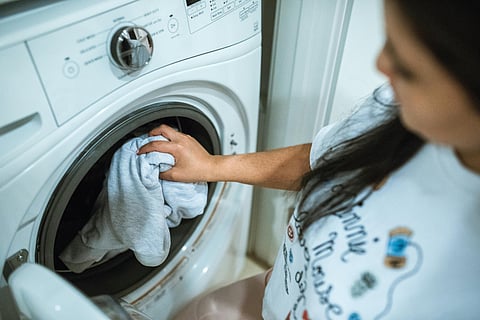
- Topics
- Feature
- Opportunities & Events
- About
- Hindi Portal
- Data
- Topics
- Feature
- Opportunities & Events
- About
- Hindi Portal
- Data

India is facing an escalating water crisis, with both urban and rural areas struggling to meet rising demand. Traditional laundry practices consume vast amounts of water, further exacerbating this issue. As water shortages become more frequent, the need for innovative solutions is more urgent than ever. Liquid CO₂ (carbon dioxide) laundry technology offers a transformative alternative—a waterless, energy-efficient, and fabric-friendly approach to garment cleaning. Already gaining traction in the United States, this technology holds significant potential for widespread adoption in India.
The water crisis and laundry’s role
Laundry is an often-overlooked contributor to water consumption. A single residential washing machine can use up to 150 liters per load. While many in India still rely on handwashing, middle- and upper-class families increasingly employ domestic labour for washing clothes, often using tanker-supplied water in water-stressed cities. This reliance has driven up the overall cost of laundry, as both labour costs and tanker water prices continue to rise.
With India's growing population and rapid urbanization, reducing water dependency without compromising hygiene and efficiency is imperative. Liquid CO₂ cleaning technology offers a promising solution.
How liquid CO₂ laundry works
Liquid CO₂ laundry technology replaces water with compressed carbon dioxide in a closed-loop system. The process works as follows:
Cleaning without water – Instead of detergent and water, liquid CO₂ dissolves and lifts away dirt, oil, and stains.
Fabric-friendly process – Unlike traditional washing methods, which weaken fibers over time, CO₂ cleaning is gentle and extends garment lifespan.
Instant drying – Since no water is used, clothes come out completely dry, eliminating the need for energy-intensive dryers.
Minimal waste and pollution – The CO₂ is continuously recycled within the machine, reducing emissions and environmental impact. Moreover, liquid CO₂ is generally non-toxic and biodegradable.
This technology has already been embraced by sustainability-focused brands like Patagonia, which has partnered with Tersus Solutions, a U.S. based manufacturer of liquid CO₂ machines to clean, repair, and recycle its used garments with its waterless liquid CO₂ based cleaning system. A key part of this collaboration is Tersus’s down recycling program, where old Patagonia jackets and sleeping bags are cleaned, and their down is extracted and reused in new products, reducing waste and supporting a circular economy.
Similar services, including garment cleaning, repair, upcycling, and recycling, are also offered for brands like The North Face, Eileen Fisher, and REI, helping them extend the life of their products and promote sustainable fashion.
Global success and relevance for India
In the U.S., companies like Tersus Solutions have successfully implemented liquid CO₂ laundry in the hospitality, healthcare, and fashion industries. While this technology has not yet penetrated the residential market in the U.S.—due to the country’s abundant water supply and lower population density—it is well-suited for India’s urban landscape, where laundromat facilities are more practical. Several Indian companies are already supplying liquid CO₂ to the food industry, pharmaceuticals, and other industries for their processes. Therefore, waterless need not be concerned about its supply.
Key sectors in India that could benefit from waterless laundry include:
Hotels and Hospitals – Large-scale laundries in these industries consume massive amounts of water. A shift to liquid CO₂ technology could lead to significant savings.
Residential and Apartment Complexes – A single liquid CO₂ laundromat could serve 50-100 households using a pick-up and drop-off business model. Alternatively, customers could bring in their own clothes, reducing reliance on tanker water and manual labor.
Military and Defense – Waterless laundry would be particularly useful for army bases and other establishments that require frequent cleaning of uniforms.
Challenges and opportunities
Despite its advantages, liquid CO₂ laundry technology faces challenges, primarily related to cost and accessibility. Importing the machines is expensive for small businesses. However, local manufacturing and partnerships with engineering institutions could help reduce costs and encourage widespread adoption. The Make in India initiative could play a crucial role by offering tax incentives for such innovations.
Several other water-efficient laundry alternatives are also being explored globally:
80Wash (India): Uses supersaturated steam for efficient garment cleaning.
Xeros Technology (UK): Employs polymer beads to minimize water use.
China’s Patent CN105063960B: Focuses on static dust removal, though still in early development.
Each of the above offers unique benefits. However, liquid CO₂ technology seems to stand out due to its commercial success and scalability. Tersus and other companies in the U.S. have demonstrated its viability with key partnerships and entrepreneurs using the machines to serve hotels and hospitals.
Potential impact on India
A nationwide shift to waterless laundry could yield enormous environmental and economic benefits:
Water savings: If every Indian citizen switched to liquid CO₂ laundromats, the country could conserve up to 10 billion cubic meters of water annually.
Job creation: The industry could generate employment in machine operation, logistics, technical support, and customer service.
Restaurant industry applications: Since liquid CO₂ is non-toxic and biodegradable, it could potentially be adapted for dishwashing in restaurants, leading to additional water savings.
As India’s water crisis intensifies, adopting sustainable alternatives is no longer optional—it is essential. Liquid CO₂ laundry technology provides a viable, eco-friendly solution that reduces water consumption, extends fabric durability, and improves energy efficiency. By encouraging local production, supporting research, and offering incentives for sustainable practices, India can lead the way in waterless laundry innovation. The time to act is now to ensure a water-secure future for generations to come.
Note: The author has no personal or financial ties to the companies mentioned, and any emphasis on liquid CO₂ reflects the author's perspective. Several other waterless laundry technologies likely exist, each with unique benefits. Entrepreneurs interested in this market are encouraged to conduct their own research to determine the most suitable technology.